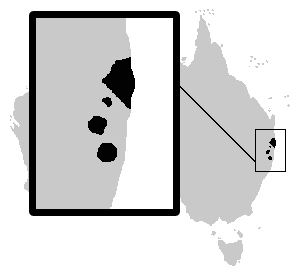الضفدع الكيسي
This article includes a list of references, but its sources remain unclear because it has insufficient inline citations. (November 2020) |
| الضفدع الكيسي | |
|---|---|

| |
| التصنيف العلمي | |
| أصنوفة غير معروفة (أصلحها): | Assa |
| Species: | Template:Taxonomy/AssaA. darlingtoni
|
| Binomial name | |
| Template:Taxonomy/AssaAssa darlingtoni Loveridge, (1933)
| |

| |
| Range of the pouched frog | |
The pouched frog (Assa darlingtoni), or hip pocket frog,[1] is a small, terrestrial frog found in rainforests in mountain areas of south-eastern Queensland and northern New South Wales, Australia. It is the sole species within the genus Assa, and is part of the family Myobatrachidae.
. . . . . . . . . . . . . . . . . . . . . . . . . . . . . . . . . . . . . . . . . . . . . . . . . . . . . . . . . . . . . . . . . . . . . . . . . . . . . . . . . . . . . . . . . . . . . . . . . . . . . . . . . . . . . . . . . . . . . . . . . . . . . . . . . . . . . . . . . . . . . . . . . . . . . . . . . . . . . . . . . . . . . . . .
Description
It is a small frog about 2.5 cm long, red-brown in colour, with some individuals having reverse V shaped patches and/or with light brown dots randomly on their backs. Most specimens have a darker brown stripe that runs from the nostril through the eye down the side of the body. A skin fold is present on either side of the frog running from its eye to its hip. Its hands and feet are completely free of webbing and discs, but the tips of the fingers and toes are swollen. The eye is gold with brown flecks and when the pupil is constricted it is horizontal. There is a 'pocket' on its hip where the frog's tadpoles travel to after hatching.
Ecology and behaviour
This frog hides under logs, rocks, and leaf litter in rainforests and adjacent wet sclerophyll forests. It may call through the day but calling is most intense during dawn and dusk. Its call is a very quiet eh-eh-eh-eh-eh-eh, usually six to ten notes. This frog crawls rather than hops. Females are believed to first start breeding between 2 and 3 years and a single female may produce 1–50 eggs a year. Eggs are laid on the land (under decomposing logs, rock or leaf litter) as the tadpoles do not need water for metamorphosis. Breeding takes place during spring and summer. Both male and female frogs guard the nest of eggs and the male carries the tadpoles in the pouch once they have hatched. The tadpoles will reside in the pouch until they have morphed.
This species formerly experienced declines, however it has recovered.[بحاجة لمصدر]
Similar species
Although this frog is the only species in its genus, it may be confused with Philoria loveridgei (Loveridge's frog). Philoria loveridgei has angular skin folds on its dorsal surface and thicker arms than Assa darlingtoni.
References
- ^ Pickrell, John (2019-12-17). "As fires rage across Australia, fears grow for rare species". sciencemag.org. Retrieved 2020-04-26.
{{cite web}}: CS1 maint: url-status (link)
- Hero; et al. (2004). "Assa darlingtoni". IUCN Red List of Threatened Species. 2004. Retrieved 11 May 2006.
{{cite journal}}: Invalid|ref=harv(help) Database entry includes a range map and a brief justification of why this species is of least concern - Frogs Australia Network – frog call sound clip available here.
- New South Wales Office of Environment and Heritage (2014) 'Pouched Frog- profile', http://www.environment.nsw.gov.au/threatenedspeciesapp/profile.aspx?id=10070 accessed 7 August 2016. Includes recovery strategies.
- CS1 maint: url-status
- Articles lacking in-text citations from November 2020
- All articles lacking in-text citations
- أنواع القائمة الحمراء غير المهددة
- Automatic taxobox cleanup
- Articles with unsourced statements from November 2020
- Cite iucn maint
- Myobatrachidae
- Amphibians of Queensland
- Amphibians of New South Wales
- Monotypic amphibian genera
- Amphibians described in 1933
- Frogs of Australia
